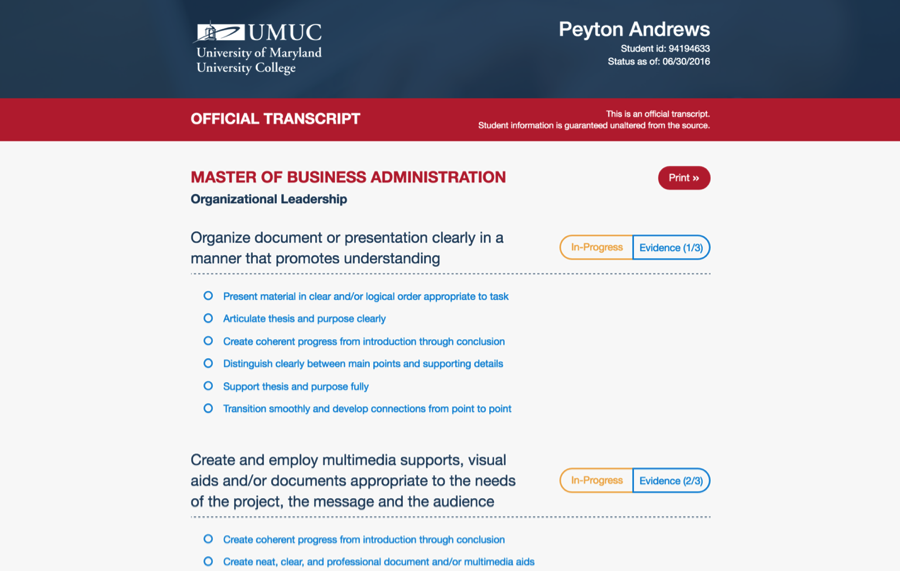Here’s an unavoidable truth: the vast majority of students expecting a degree in 2017 remain prisoners of a 1940s technology—their college transcript. For these students, a truly comprehensive record of their college experience, including extra-curricular activities or examples of job-specific competencies, skills, and workplace experiences, remains hidden within a set of static and truncated course titles.
Conventional college transcripts often fail to communicate the very evidence that many employers are seeking. LinkedIn’s 2016 survey of nearly 300 hiring managers revealed that 58% were concerned that a shortage of soft skills, such as teamwork and problem solving, reduces productivity. The Wall Street Journal’s survey of more than 900 C-Suite executives found that 92% valued soft skills as much, or more, than technical skills required for a job.
For many students, it is puzzling why their immersive and work-focused experiences get lost in translation. If virtually every waking moment of their lives is easily documented through social media, why can’t their school effectively communicate a more complete picture of their student experience?
While this is not a new phenomenon, there is new evidence that the efforts of several innovative schools, in partnership with technology solution providers, may be bearing fruit. The Comprehensive Student Record (CSR) project is laying the groundwork for many of these efforts. Designed to supplement, rather than replace, the traditional transcript, the CSR is a year-old effort funded by the Lumina Foundation, in partnership with the American Association of Collegiate Registrars and Admissions Officers (AACRAO), and Student Affairs Administrators in Higher Education (NASPA).
At this month’s Parchment Summit, we were able to catch a first glimpse of CSR’s progress to date. Not surprisingly, Parchment, which offers a digital credentialing platform, has played a key role in the emergence of this movement. According to Parchment, its services are now used by more than 2.8 million learners, accounting for secondary, postsecondary, and GED programs, and licensing boards.
The CSR is attempting to build a framework for further innovation through ongoing engagement with faculty, registrars, and student affairs officers at 12 pilot institutions. These schools represent a diverse spectrum of higher education institutions, including LaGuardia Community College, the University of South Carolina, Stanford University, and Brandman University, a recognized provider of competency-based education (CBE). CSR pilots at Elon University and the University of Maryland, University College (UMUC) are both notable in their own right, and reflect the priorities of two very distinct institutional missions.
 Extended Transcript: University of Maryland, University College’s (UMUC) Comprehensive Student Record (CSR) pilot
Extended Transcript: University of Maryland, University College’s (UMUC) Comprehensive Student Record (CSR) pilot

 Visual EXP: Elon University’s Comprehensive Student Record (CSR) pilot, via Parchment platform
Visual EXP: Elon University’s Comprehensive Student Record (CSR) pilot, via Parchment platform
UMUC
UMUC’s CSR pilot, the Extended Transcript (eT), is designed to more effectively communicate progress through a CBE program, with particular attention paid to how and when a student has mastered specific content and skill competencies. UMUC’s project is part of a partnership with Learning Objects, a Cengage company, and grows out of a concern that CBE programs could be hampered by the absence of broadly accepted standards for measuring and reporting competencies. UMUC has piloted the eT in its MBA and cybersecurity programs, and is collecting feedback and data from about 2,000 adult learners. UMUC’s project intends to be laser focused on how these learners, and the employers who may hire them, will make use of the highly granular data reported about specific competencies through the use of the Extended Transcript. Extended Transcript: University of Maryland, University College’s (UMUC) Comprehensive Student Record (CSR) pilot
Extended Transcript: University of Maryland, University College’s (UMUC) Comprehensive Student Record (CSR) pilot
Elon University
Unlike UMUC, Elon University serves a traditional-aged student population that resides mostly on campus. Elon has focused on the integration of non-credit student experiences into a hyperlinked, geo-tagged Visual Experiential Profile, or Visual EXP, delivered via the Parchment platform. The Visual EXP is designed to supplement, rather than replace, Elon’s conventional transcript. According to Elon’s registrar, Dr. Rodney Parks, the primary goal of the Visual EXP is to enable students to iteratively curate evidence of their extra-curricular and non-credit experiences. Elon is hoping that this capability will enable employers to receive a more complete and predictive assessment of Elon’s graduates. Parks reports that about 800 Elon undergraduates have been using the Visual EXP. Initial survey findings indicate that while students like the goal of the EXP, they are asking to include more evidence of work experiences, in addition to the existing extra-curricular options.
 Visual EXP: Elon University’s Comprehensive Student Record (CSR) pilot, via Parchment platform
Visual EXP: Elon University’s Comprehensive Student Record (CSR) pilot, via Parchment platform

